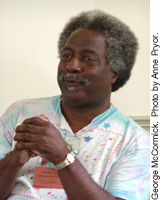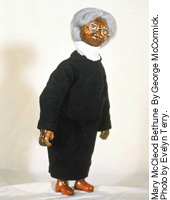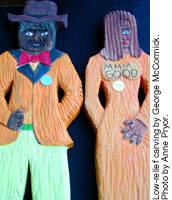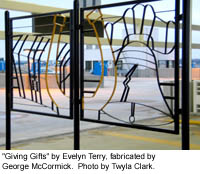Home | Search | The Artists | Teaching | Hiring | About This Site | Contact Us

Woodcarving and Metalwork
Milwaukee, WI
“You’ve got to have a look of your own.”
 You could call George McCormick’s art “eclectic.”
That means that George’s art is in different forms and with different materials. Plus, he
You could call George McCormick’s art “eclectic.”
That means that George’s art is in different forms and with different materials. Plus, he
![]() finds
inspiration for his
art from many sources.
finds
inspiration for his
art from many sources.
Dolls in the Round
Over the years, George developed art with of look of its own. In the early 1990s, he learned to make porcelain dolls from his artist friend, Linda Handy. In this process he used pre-made doll forms. That was OK for a while, but George wanted more control over the final outcome. He wanted to make the entire art piece just the way he envisioned it.
George changed techniques and in 1994 he started carving. As George recalls, “I wanted to sculpt in wood, and I prayed for God to show me how to do dolls and figure wood carving.”
Shortly after he prayed for guidance, George’s son gave him a knife for Christmas. Soon after that, George was working at his hospital job and found a piece of wood on the floor. George saw the two events as a sign and he started making three-dimensional figures. He calls this kind of carving, “carving in the round.”
George chose to use basswood because it has tight grain and is soft enough to carve with hand tools. It is a favorite wood for many carvers because of these qualities. Basswood is light colored so carvers often paint their basswood carvings. Acrylic paints gave George the look he wanted on the finished carving. He made clothes for each figure that showed their character.
 This picture shows George’s carving of Mary
McLeod Bethune, a pioneering
African-American teacher from the early twentieth century. George won first place at the 1996 Holiday of Black Dolls Festival in Columbus, Ohio for this carving of Ms. Bethune.
This picture shows George’s carving of Mary
McLeod Bethune, a pioneering
African-American teacher from the early twentieth century. George won first place at the 1996 Holiday of Black Dolls Festival in Columbus, Ohio for this carving of Ms. Bethune.
Switching to Low-relief Carving
A few years later, George shifted his focus away from carving dolls. He began to carve low-relief carvings on flat pieces of wood. “It’s much more pleasing to me,” he explains.
 Carving on a flat surface allows George to
create more intricate designs. Sometimes he
carves words into his pieces, like in the figures shown here.
Carving on a flat surface allows George to
create more intricate designs. Sometimes he
carves words into his pieces, like in the figures shown here.
For more detail, George sometimes burns the wood with a special pen burner. He likes how burning the wood gives his carvings depth, definition, texture, and color. Unlike many artists who burn wood, George doesn’t burn the wood with particular precision or with a planned design in mind. As George says, “I don’t see the whole carving. It evolves as I’m carving.”
Just like with his dolls, George uses basswood and acrylic paint for his low-relief carving. He finds some of the wood he uses. He buys some and some he gets from one of his carving friends, artist Phil Odden.
When George designs a carving, he might roughly sketch something on paper. Sometimes he sketches directly on the wood. Later, if George doesn’t like how a carving is going, he discards it but he might reuse the wood later.
A Voice in the Night
Just as George reuses wood for his relief carvings, often he uses discarded metals to make metal sculptures. George’s latest art form is metalworking.
“The welding came in 1999. I was asleep and a voice, which I say is God, spoke to me at four o’clock in the morning and told me to go study welding. And I answered that.”
George had always been afraid of welding. His stepfather had been a welder and George saw him come home from work with burns on his skin. But George gathered his courage and took an introductory welding class. As soon as he held the torch burning at 6,000 degrees Fahrenheit, he knew he was meant to be a welder.
George typically uses steel to make large pieces, like benches and huge sculptures, and smaller pieces, like the first thing he ever welded. He called that sculpture “Trash Dancers” because he made the dancers out of trash metal.

![]() Do
you ever go to Mitchell Field, Milwaukee’s airport? George worked with artist Evelyn Terry to create twelve painted
wrought iron panels. The sculptures are in the airport’s parking garage. Look for them the next time you’re there! Click on the image to see what parking level they’re on.
Do
you ever go to Mitchell Field, Milwaukee’s airport? George worked with artist Evelyn Terry to create twelve painted
wrought iron panels. The sculptures are in the airport’s parking garage. Look for them the next time you’re there! Click on the image to see what parking level they’re on.
One of the important parts of metalworking for George is his personal connection to the art form. He feels that his metal sculptures represent a part of him and his life. He says he used to be like the discarded metal—in the streets and not doing much good. But now, he makes art. “What I was given was worth more than money.”
More than One
George is happy that he doesn’t feel tied to just one art form. “That’s not who I am. I can do different things. I was given ceramics. I was given wood. I was given metal.”
George uses all these art forms to express his ideas. But where do his ideas come from? —From important traditions in his life! The next page will tell you more...

For Educators:
“I’ve got all these different stories to tell. Little snapshots here and there.”
– George McCormick
Home | Search | The Artists | Teaching | Hiring | About This Site | Contact Us
